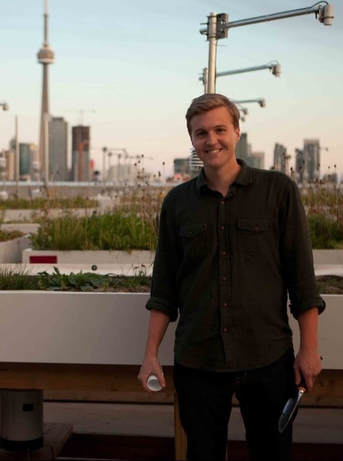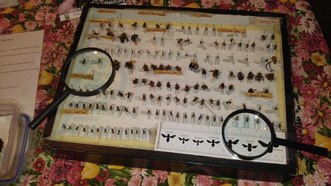 April 9th @Royal Botanical Gardens 7.30 pm to 9.30 pm. You do not want to miss this talk with Scott MacIvor! Not only is Scott a treat to listen to, with his winning way of delivering a presentation, but he is a renowned native bee specialist, working all over the world. Hosted by the Hamilton Naturalists' Club, in this talk, Scott MaIvor will provide an overview of the bees of Hamilton and Southern Ontario. He will examine the primary drivers of bee diversity and pollination services in cities based on the most research scientific literature from around the world, and question whether or not cities could be a refuge for these essential pollinator species. This region supports hundreds of native bee species and the talk will conclude with some key criteria for home and community gardeners interested in supporting and enhancing their populations. Free. All welcome. Meet & greet at 7pm. Contact Bron:[email protected] More about Scott Scott MacIvor is an Assistant Professor in the Department of Biological Sciences at the University of Toronto Scarborough. He is interested in plants and pollinators in cities and more broadly, the biodiversity and ecosystem functioning of green infrastructure, including public and private gardens, parks, and green roofs. Scott is also a researcher at the green roof innovation testing (GRIT) lab at the University of Toronto in the faculty of Landscape Architecture, and has worked with the city of Toronto Planning Division on a number of projects including the 'Bees of Toronto' and the 'Guidelines for Biodiverse Green Roofs'. Read a blog post about a presentation gave for the Pollinator Paradise Project in November, 2016.
0 Comments
 Wildbees' Display Wildbees' Display "Keeping ‘corridors of connection’ is better for bees and better for seeds," Dr. Clement Kent of York University. The Pollination Guelph Symposium 2018 rocked Team Pollinator Paradise Project to the core. Nurturing Pollinators from the Soil to the Tree-tops was the theme of this year's Symposium and they meant it. We heard from many speakers, including Pollination Guelph's Victoria MacPhail who provided project updates, and York University's Dr. Clement Kent, whose presentation was called Using Genetics to help Bees, and Bees to help Ecosystem Genetics. Clement said that plant genetic diversity is more important than bee diversity. Point is, we want to avoid inbreeding amongst bee species. With habitat, the more seed set, the better chances for cross pollination. Clement told us about his redbud tree that was flowering, but had no seeds. Turns out that his tree was the only redbud in the neighbourhood, so it wasn't until more redbuds came to the neighbourhood that the tree finally seeded. The lesson is that we need to up the density of plants, while also protecting pollinators. We need to keep up the genetic diversity of pollinators. Read on for some more coverage of the day! The Silvercreek Park Hydro Corridor Project Plant List: The Silvercreek Park Hydro Corridor Project Plant List: The Silvercreek Park Hydro Corridor Project "Diversity is Stability." Moritz Sanio, Trees for Guelph. Making lemonade or What happened after the buckthorn was Gone: The Silvercreek Park Hydro Corridor Project was a joint presentation by Moritz Sanio (Trees for Guelph) and Lisa Mactaggart, OLA Arium Design Group. So what happened when Hydro One cut the forest along the 4 acres, Silvercreek Park hydro corridor? The neighbours were upset. What they didn't know was the this "forest" was composed of mostly invasive buckthorn. Once they were educated on how undesirable buckthorn is, they recognized an opportunity to create biodiversity by planting native plant habitat! In the process, the neighbours strengthened their community cohesion and engagement, while gaining a meadow. We learned from Moritz that planting in the spring is a European model that is not the useful for introducing a meadow. We need to follow the model that nature provides. In putting seed into the landscape, 6 to 7 inches apart is ideal. Put seeds down in the winter or late fall if you want the seeds to germinate in the winter, so that they can stratify. That is, stratification breaks seeds' dormancy and they come up on their own accord, "so be patient," Moritz advised. Snow is handy because you can actually see the seed! Be careful not to step on the tiny seedlings. Planting day for the project was May, 2016 and you can read all about it, as well as the plants that were used, in the Milkweed Journal In brief, the mix, they used contained the usual suspects--the asters, goldenrods and brown-eyed Susans. Then came the Big Bluestem, New Jersey tea, and plants such as Canada anemone and Wild Bergamon, which is great in the city. Indiangrass was also used. Moritz shared that Canadian Wild Rye, planted first, will secure the site for other wild flowers and the relinquish it to these other flowers. "The native species bring in the pollinators. It begins with the insects, then other creatures will follow, the frogs, garter-snakes, and so on," Moritz said. Now, there is an entire neighbourhood of folks whose backyards face the corridor that work together to keep the site maintained--watering it, and weeding. Hydro One continues to maintain it as a compliant site and the City of Guelph does the mowing. |
Archives
December 2023
Categories |
|
|
Butterflyway Hamilton: www.facebook.com/butterflywayhamilton/
Environment Hamilton: https://www.environmenthamilton.org/ Hamilton Naturalists' Club: https://hamiltonnature.org/ |

 RSS Feed
RSS Feed